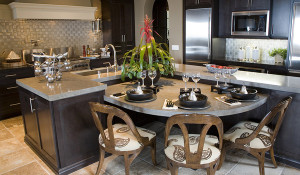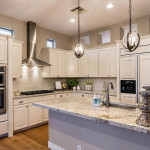Interior Design Principles
 The proportion and placement of items in your home results in good interior design. The following design principles will help you get ready to stage and list your home for sale, as well as help you set up your new home for optimal living and enjoyment.
The proportion and placement of items in your home results in good interior design. The following design principles will help you get ready to stage and list your home for sale, as well as help you set up your new home for optimal living and enjoyment.
Area rugs are a very large component of interior design, where placement and proportion are particularly useful. In the living room, if you have placed your furniture against the walls, you can either pick a rug size that will allow your sofa and side chairs to rest half on the rug and half off of it, or you can choose a smaller rug where no seating touches it. If your living area is larger than average, you’re better off with an area rug that’s large enough to have every piece of furniture fully placed on it. In the bedroom, your aim is to make sure you are stepping onto a rug from the bed. Therefore, you can position your area rug under the bed so that it peeks out two to three feet on either side and at the foot, without the nightstands resting on the rug. (A good guideline to follow is 8 by 10 feet for a queen bed and 9 by 12 feet for a king). Alternatively, consider placing a runner or smaller 3 by 5-foot rug on each side of the bed.
Another area where placement and proportion are important is hanging artwork or design pieces on the walls of your home. The basic rule of thumb is to keep artwork at eye level, just as museums do. If most members of your household are on the short side, hang art so the midpoint is about 57 inches from the floor. Or, in rooms with ceilings higher than 8 feet, hang any artwork a bit higher than 60 inches from the floor from the midpoint of the art. The exceptions here are if you are hanging your artwork over a headboard or a sofa. In these situations, make sure the bottom of the frame is 8 to 10 inches above the piece of furniture. This ensures the artwork is visually connected to the furniture and not free-floating above it. Finally, if the artwork is very large (taller than 10 feet), disregard the midpoint rule and just position the bottom edge of the piece at least a foot from the floor.
Finally, the placement of lighting is a critical component of good interior design. For pendant lights over a kitchen island, or a chandelier over a dining room table, for example, aim to hang these lights so the bottom hangs 30 to 34 inches from the table surface. With regard to floor and table lamps, ensure the bottom edge of the lampshade is at eye level or just above when you are seated. For a lamp on a nightstand, make sure the bottom of the shade is at chin level when you are seated in bed. Finally, with sconces, the placement between them is the critical component. For hallway sconces, position them 8 to 10 feet apart, and for bathroom mirror sconces, position them 36 to 40 inches apart, to ensure an even display of light.
These interior design principles are tried and true, and work in every type of home. I hope they will serve you well in your home selling or home designing adventure.
Do you know the value of your home? Click here to get a free no obligation estimate.




